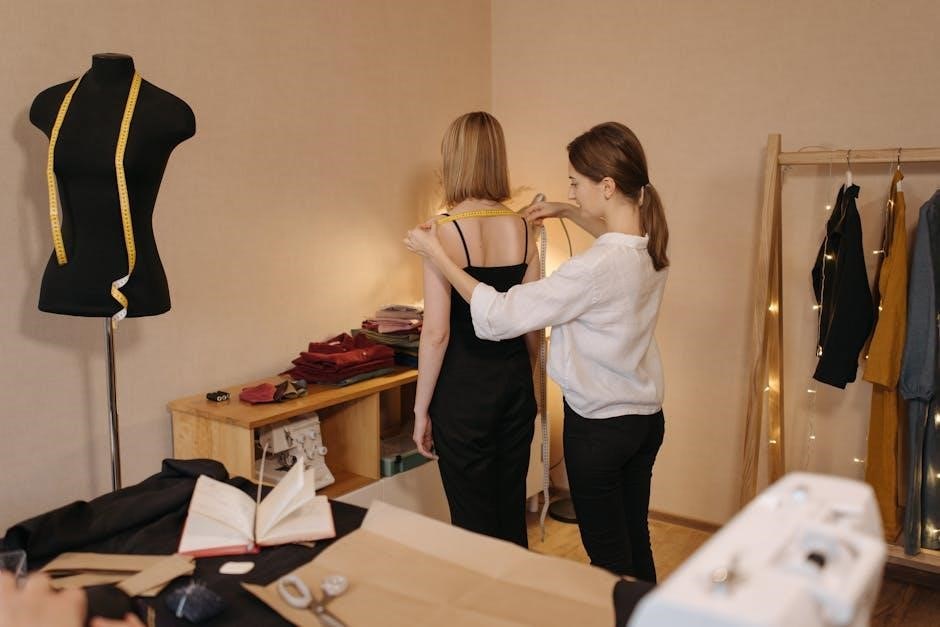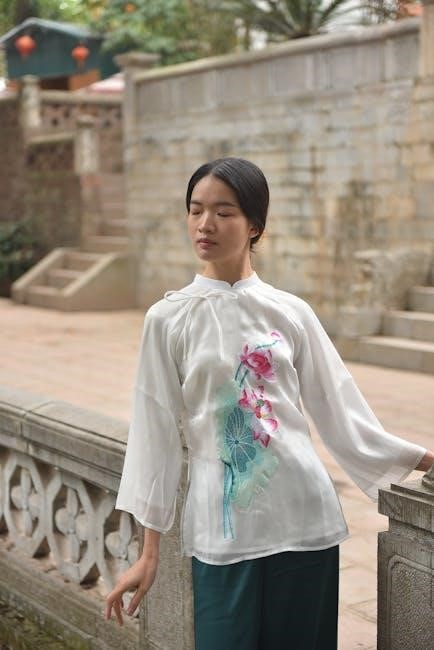Proper blouse measurements ensure a perfect fit, enhancing both comfort and appearance. Accurate measurements are crucial for tailoring and selecting styles that flatter your body type.
1.1 Importance of Accurate Measurements
Accurate measurements are essential for ensuring a blouse fits perfectly, combining comfort and style. Incorrect measurements can lead to alterations or discomfort, while precise ones enhance the overall appearance. Proper fitting allows for ease of movement and a flattering silhouette. By understanding your body dimensions, you can choose styles and fabrics that complement your figure. This guide provides expert tips to avoid measuring mistakes, ensuring your blouse fits flawlessly and reflects your personal style. Tailoring to your exact measurements guarantees a bespoke look and feel.
1.2 Brief Overview of the Measurement Process
Taking accurate blouse measurements involves a systematic approach to ensure the best fit. Start by gathering essential tools like a flexible measuring tape and a full-length mirror. Begin with the bust measurement, ensuring the tape is level and not too tight. Next, measure the waist at its natural narrowest point. Then, measure the hips about 7-9 inches below the waistline. Shoulder and sleeve length measurements follow, with the tape placed from the base of the neck to the desired sleeve end. Record all measurements carefully to use them for pattern adjustments or size chart comparisons. This process ensures a tailored fit, avoiding common mistakes like uneven placement or measuring over clothing. By following these steps, you can achieve precise measurements for a bespoke blouse that flatters your silhouette and meets your styling preferences.

Key Measurements for a Blouse
The essential measurements for a blouse include bust, waist, hips, shoulders, and sleeve length. Each plays a vital role in ensuring a tailored fit and proper appearance.

2.1 Bust Measurement
The bust measurement is taken around the fullest part of the chest, keeping the tape level and parallel to the floor. It’s important to stand straight and relax the arms. For accuracy, the measuring tape should not be too tight or too loose. This measurement is crucial for determining the blouse size and ensuring a comfortable fit. Proper alignment ensures the garment drapes well and provides the desired silhouette. Always measure over a well-fitting bra for the most accurate results.
2.2 Waist Measurement
The waist measurement is taken around the narrowest part of your torso, typically just above the navel. It’s essential for determining the fit of the blouse at the waistline. To measure accurately, stand straight and wrap the tape snugly but not too tight. This measurement helps create a defined silhouette and ensures the blouse sits comfortably. For tailored fits, precise waist measurements are crucial, as they directly impact the blouse’s style and comfort. Always measure without clothing or over thin fabric for the most accurate result.
2.3 Hip Measurement
The hip measurement is taken around the widest part of your hips, typically 7-9 inches below your natural waistline. This measurement helps ensure the blouse fits well around your lower torso. For accuracy, stand straight and keep the tape level. The hip measurement is crucial for determining the fit of the blouse, especially if it’s tailored to be fitted or flared. A correct hip measurement ensures the garment drapes properly and maintains its shape. Always use a flexible measuring tape for precise results.
2.4 Shoulder Measurement
Shoulder measurement is crucial for ensuring proper fit, especially for blouses with sleeves or structured designs. To measure, place the tape horizontally across the top of your shoulders, from one tip to the other. Ensure the tape is level and not too tight or loose. Accurate shoulder measurements help in achieving the right balance between comfort and style, preventing issues like slipping or restricted movement. This measurement is also vital for determining sleeve placement and overall garment alignment.
2.5 Sleeve Length Measurement
Sleeve length is measured from the shoulder seam to the wrist. For a standard blouse, measure from the center back of the neck, over the shoulder, and down to the desired cuff length. Ensure the arm is slightly bent for comfort. This measurement determines the sleeve style, whether short, three-quarter, or long. Accurate sleeve length ensures a balanced look with your body proportions. Use a flexible tape to maintain a smooth line while measuring, ensuring the tape isn’t too tight or loose.

Tools Needed for Taking Measurements
- A flexible measuring tape for accurate body measurements.
- A full-length mirror to ensure proper tape placement.
- Pen and paper to record measurements for future reference.

3.1 Flexible Measuring Tape
A flexible measuring tape is essential for taking precise body measurements. It allows you to wrap the tape snugly around curves without slipping, ensuring accuracy. Unlike rigid tapes, it conforms to your body shape, making it ideal for measuring bust, waist, and hips. A 60-inch tape is recommended for ease of use. Always ensure the tape is level and not too tight or loose. This tool is indispensable for achieving a perfect fit in tailoring or selecting ready-made blouses.
3.2 Full-Length Mirror
A full-length mirror is essential for taking accurate measurements, as it allows you to see yourself from head to toe. This helps maintain proper posture and ensures the measuring tape remains level and correctly positioned. By using a mirror, you can verify that your measurements are taken consistently and avoid common errors like uneven placement. It also aids in visualizing how the blouse will fit, helping you achieve a more precise and flattering result. Invest in a good-quality mirror for the best outcomes.
3.4 Pen and Paper for Recording Measurements
A pen and paper are essential for accurately recording your measurements, ensuring clarity and organization. Writing down each measurement immediately after taking it helps prevent errors and allows for easy reference during tailoring or shopping. Keeping a dedicated record also makes it simpler to track changes over time and ensures consistency when creating or altering garments. This step is crucial for achieving a precise fit and avoiding costly mistakes in your blouse-making process.

Step-by-Step Measurement Techniques
Start by measuring your bust at the fullest point, keeping the tape level and relaxed. Next, measure your waist at its narrowest point. Then, measure your hips 7-9 inches below your waist. For shoulders, measure from one tip to the other. Finally, measure sleeve length from the shoulder tip to your wrist. Always use a flexible tape and take measurements directly on your skin for accuracy. Ensure the tape is level and not too tight or loose, and maintain good posture throughout the process. Record each measurement carefully to ensure a perfect fit for your blouse.
4;1 How to Measure Your Bust
To measure your bust accurately, wrap the flexible measuring tape around the fullest part of your chest, ensuring it remains level and parallel to the floor. Stand straight and relax your shoulders. The tape should be snug but not tight, avoiding any gap. For the most accurate measurement, wear a thin garment or no top at all; If wearing a bra, ensure it is not constricting. Take the measurement while breathing naturally to capture your natural bust size. If possible, have someone assist to ensure the tape remains level and properly positioned. This method works for all bust sizes, though larger busts may require careful adjustment to prevent the tape from pressing too firmly into the skin. Avoid measuring over bulky clothing, as this can distort the measurement. Accurate bust measurement is essential for a well-fitting blouse, ensuring comfort and a flattering silhouette.
4.2 How to Measure Your Waist
To measure your waist accurately, stand straight and locate the narrowest part of your torso, typically just above your navel. Wrap the flexible measuring tape around this area, ensuring it remains level and parallel to the floor. The tape should be snug but not tight, allowing for a full range of motion. This measurement is crucial for determining the fit of your blouse, especially if you prefer a tailored or fitted style. Record the number to use in size charts or tailoring patterns.
4.3 How to Measure Your Hips
To measure your hips, stand straight and wrap the flexible measuring tape around the widest part of your hips, usually 7-9 inches below your waistline. Ensure the tape is level and not twisted. Keep your feet shoulder-width apart and relax your stance for an accurate measurement. Avoid pulling the tape too tight or holding it too loose. This measurement is crucial for determining the fit and style of your blouse, especially for tailored or fitted designs. Record the measurement carefully for later use in sizing charts or patterns.
4.4 How to Measure Your Shoulder and Sleeve Length
To measure your shoulder, stand straight and place the tape horizontally across the back, from the base of one shoulder to the other. For sleeve length, start at the shoulder tip and measure down to the wrist for short sleeves or the desired length for long sleeves. Keep your arm slightly bent and relaxed to ensure accuracy. Use a full-length mirror to verify the tape’s position and levelness. Record these measurements carefully to ensure a perfect fit for your blouse.
Common Mistakes to Avoid
Common errors include improper measuring tape placement, not keeping it level, and measuring over clothing. These mistakes can lead to an ill-fitting blouse.
5.1 Improper Measuring Tape Placement
Improper placement of the measuring tape is a common mistake that can lead to inaccurate measurements. The tape should be positioned correctly—neither too tight nor too loose—and should be parallel to the floor. Twisting or slanting the tape can distort measurements, especially around the bust, waist, and hips. Always ensure the tape lies flat against the skin without compressing the body. Proper placement ensures a precise fit and avoids alterations later. Refer to guides for visual examples to master the technique and achieve accurate results. This step is vital for a well-fitting blouse.
5.2 Not Keeping the Measuring Tape Level
One common mistake is not keeping the measuring tape perfectly horizontal. If the tape tilts or sags, measurements become inaccurate, leading to poor fit. Always ensure the tape is level and snug against the body without pulling tight. Use a mirror to double-check placement, especially for bust and waist measurements. This ensures reliable data for tailoring or choosing sizes, avoiding alterations later. Proper alignment guarantees a comfortable, flattering fit.
5.3 Measuring Over Clothing
Measuring over clothing can lead to inaccurate results, as fabrics and layers may add extra inches. This can result in a poorly fitting blouse. Always measure directly on the skin or over a thin, form-fitting garment to ensure precision. Clothing can distort the natural body shape, making it difficult to achieve accurate measurements. For consistency, avoid bulky or loose clothing that may interfere with the measuring tape. Taking measurements over tight clothing can also cause discomfort and skew results. Opt for minimal layers to get the most accurate readings for your blouse.
Understanding Blouse Size Charts
Blouse size charts provide standardized measurements for accurate fitting. They vary by brand, so compare your measurements to the chart for the best fit and style selection.
6.1 Standard Size Charts for Blouses
Standard size charts for blouses provide a universal guide to determine the best fit based on body measurements. These charts typically include measurements for bust, waist, and hips, catering to various sizes. They help individuals select the right size when shopping online or tailoring a blouse. Most charts are available in PDF formats for easy reference. By aligning your measurements with the chart, you can ensure a perfect fit. Factors like fabric type and styling preferences may also influence size selection. Using these charts simplifies the process of achieving a flattering and comfortable fit.
6.2 How to Use a Blouse Measurement Chart
To use a blouse measurement chart, start by locating your measurements under the relevant size category. Compare your bust, waist, and hip measurements to the chart to determine the best fit. Ensure the measurements align with your body type for accuracy. Use the chart to guide fabric selection and styling choices, such as necklines and sleeves, to enhance your appearance. This step-by-step approach ensures a tailored fit and helps you make informed purchasing decisions.

Tailoring Tips for a Perfect Fit
- Adjust patterns based on your measurements for a customized fit.
- Select fabrics that complement your body type and style preferences.
7.1 Adjusting Patterns Based on Measurements
Adjusting patterns based on your measurements ensures a tailored fit. Compare your measurements to the pattern’s sizing chart and make necessary alterations. For example, if your bust measurement exceeds the pattern’s standard, add darts or adjust the front piece. Similarly, modify sleeve lengths or shoulder slopes to match your body proportions. Proper adjustments eliminate gaps or tight spots, ensuring comfort and a flattering silhouette. This step is crucial for achieving a professional finish in your handmade blouse.
7.2 Choosing the Right Fabric for Your Blouse
Selecting the right fabric is essential for a flattering and comfortable blouse. Light fabrics like chiffon or georgette work well for smaller frames, while structured fabrics like cotton or linen suit larger bust sizes. Consider your body type and measurements to ensure the fabric drapes elegantly, avoiding clingy textures for curvier figures. Soft fabrics enhance comfort, while sturdier materials provide support. Always match the fabric weight to your body proportions for a balanced look. Proper fabric choice complements your measurements, ensuring a perfect fit and stylish appearance.

Styling Options Based on Measurements
Styling options vary based on measurements, with necklines and sleeves tailored to body types. Choose styles that emphasize strengths and balance proportions for a polished look.
8.1 Selecting Necklines That Flatter Your Body Type
Selecting the right neckline enhances your appearance and comfort. For petite frames, V-necks or scoop necks elongate the torso, while square necks suit broader shoulders. Hourglass figures look stunning in sweetheart or plunging necklines, accentuating curves. Rectangular body types benefit from soft, rounded necklines like Peter Pan or crew necks. Pear-shaped individuals can balance proportions with asymmetric or off-shoulder styles. Consider your measurements to choose necklines that complement your silhouette and personal style for a flattering fit.
8.2 Choosing Sleeve Styles That Suit Your Measurements
Choosing the right sleeve style enhances comfort and aesthetics. Measure sleeve length from the shoulder to wrist for accuracy. Short sleeves suit smaller frames, while long sleeves balance broader shoulders. Cap sleeves add a stylish touch without bulk. Consider arm circumference for fitted styles. Use measurement charts to ensure the best fit. Proper sleeve length and style complement body proportions, ensuring a flattering and comfortable blouse. Always consult size charts for precise fit guidance.
Accurate blouse measurements ensure a flawless fit and style. Use this guide for future purchases and tailoring to achieve comfort and confidence in your wardrobe choices.
9.1 Summary of Key Points
Taking accurate measurements is essential for a well-fitting blouse, ensuring comfort and style. Use a flexible tape measure, maintain proper posture, and avoid measuring over bulky clothing. Record measurements carefully and refer to size charts for accurate sizing. Understand your body type to choose flattering necklines and sleeves; Avoid common mistakes like uneven tape placement or not keeping the tape level. By following these guidelines, you can achieve a perfect fit and make informed styling decisions for your blouse.
9.2 Encouragement to Use the Guide for Future Purchases
By mastering the art of blouse measurements, you’ll enjoy a seamless shopping experience. This guide empowers you to make informed choices, ensuring every purchase flatters your figure; Whether tailoring or buying ready-made, these tips will save time and effort. Use this comprehensive guide for future purchases to maintain confidence and style. Happy shopping and stitching!
